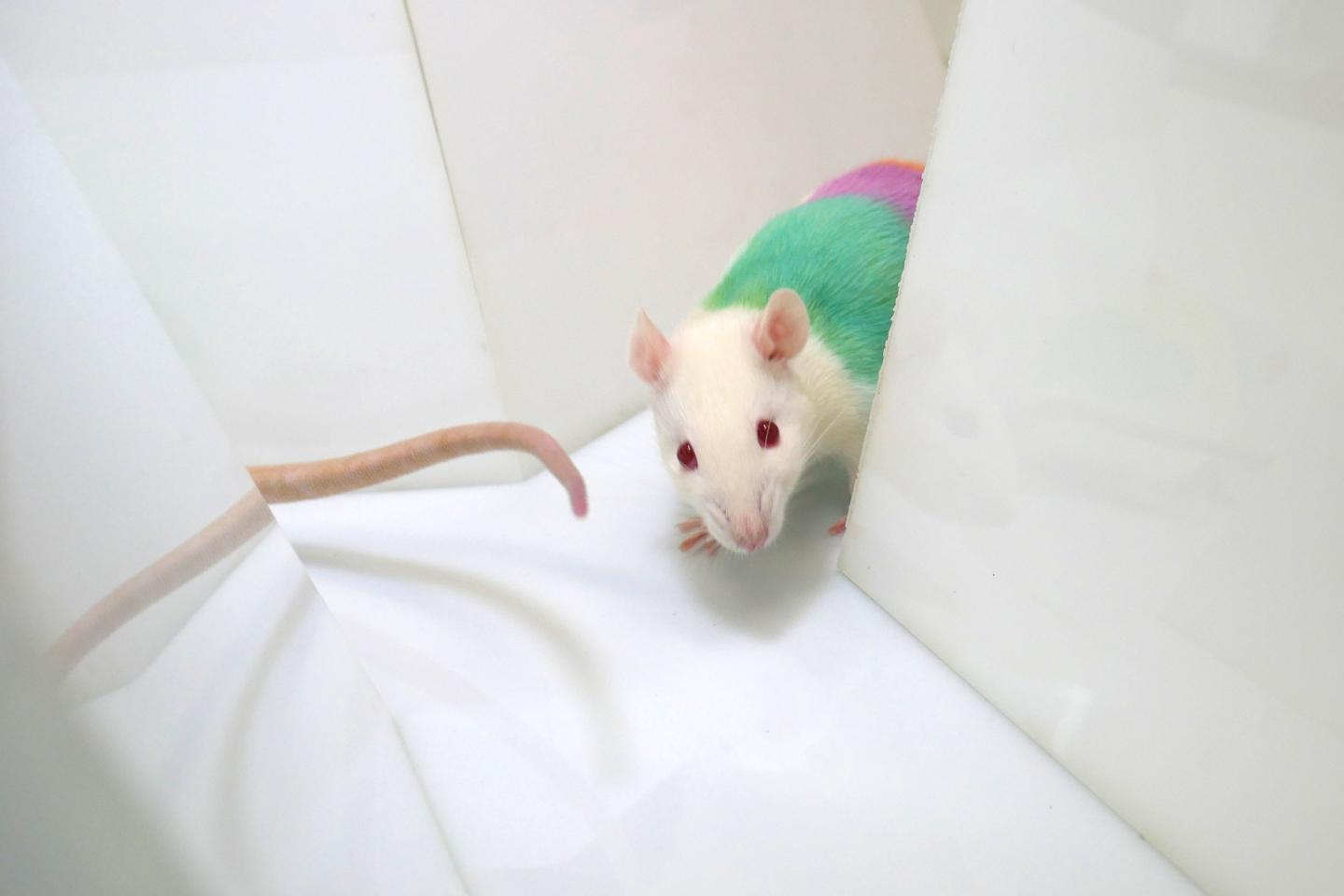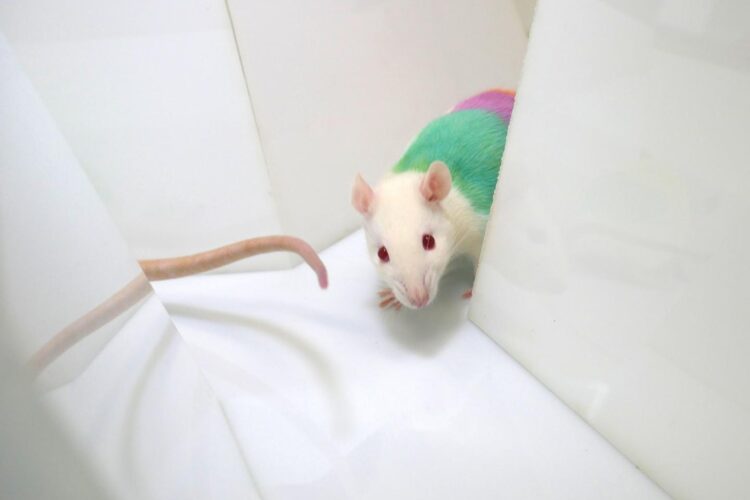Concentrate on your own task but also pay attention to others — this is the key rule for success, at least for rats when exploring as a group

Credit: Photo by Péter Palatitz.
The rat in a maze might be one of the most classic paradigms in the study of behaviour, but an international team of scientists has put a twist on this experimental motif to push the leading edge of technology and research into search strategies of collectives.
Reporting in Current Biology, the researchers describe the innovation of placing rats into a maze–not alone–but in groups in order to study their problem-solving behaviour. The study, which uses automated video tracking of the rodents simultaneously exploring their environment, reveals that rats use simple behavioural rules to achieve superior search performances in groups.
“We found that groups outperform single individuals in searching for a target, even when they have limited ability to communicate or share information. By uncovering the simple search strategy used by these groups, our study provides the means of directly inspiring algorithms for collective search applications,” says lead author Máté Nagy, who conducted this research when he was at the Max Planck Institute of Animal Behavior Department of Collective Behaviour and the University of Konstanz.
Rethinking rat in a maze
For decades, scientists have been using a classical experimental search task–which involves placing a single rat in a complex maze to search for a reward–to deepen understanding of navigation, memory, and learning. However, rats are highly social animals that build and live in complex burrow systems in nature. Yet very little is known about how they explore as a group. In the new study, researchers from institutes in Germany and Hungary turned the classical experimental search task into the first experimental study on rodent group search behaviour in a confined maze.
“Rats have long been considered as one of the most suitable model organisms of humans. Using a group of rats to model collective problem solving has pinpointed basic mechanisms employed by rodents and lent insight into underlying rules of how individuals enhance search performance by being in groups,” says senior author Tamás Vicsek from Eötvös Loránd University, one of the founders of the collective behaviour research field, and initiator of the idea to study collective exploration in this research project.
A social search task
Researchers sought to answer questions about how individuals make decisions in a group with a common target. For instance, how much should individuals concentrate on searching alone versus paying attention to what others are doing? And, how much is communication and coordination between the group members necessary?
The researchers designed and built a relatively large and complex maze with 16 endpoints. The structure of the maze meant that rats could only see others in very close proximity. Each endpoint was equipped with a water dispenser, but only one of these provided a water reward. In the search task, rats had the opportunity to locate the water reward, either alone or in groups of eight. The time taken for rats to locate the reward was measured. Rats were tracked and their individual trajectories reconstructed via automated tracking software, which allowed for deciphering the underlying characteristics of search behaviour.
The optimal balance between individual and collective
Rats in a group performed better in the search task compared to when they were on their own. When the researchers took a close look at the decisions of rats at the maze junctions, they found that the actions of those in groups could be boiled down to simple rules: go down unexplored paths but follow other rats.
In order to confirm the generality of these rules, the researchers carried out computational modelling with large numbers of simulations to show the search performance result of different combinations of these simple rules. They found that that when searching as a group, individuals performed best if they had the right balance between solo exploration and following others. Both extremes–ignoring others completely or following others too much–resulted in lower performance for the group as a whole, as well as for each of the members on the long run.
Youtube video: https:/
“In the past, scientists have described many examples of how individuals improve their navigational efficiency by following others, or by being in a group. In this study, we have combined two classical experimental components to reveal the mechanisms behind such group navigation in detail: a maze solving task performed by the highly social rat as model organisms. Using this unique combinations, we succeeded in uncovering the search strategy that allows groups to outperform individuals,” says Andrea Flack, a group leader in the Max Planck Institute of Animal Behaviour and the University of Konstanz, and co-author on the study.
The researchers say the simple decision-making rules will open doors to designing algorithms for artificial systems. “These can include tasks when a group of autonomous robots explore complex, labyrinth-like environments where only limited communication is possible, like in abandoned mines,” says Nagy who is now head of the Collective Behaviour ‘Lendület’ Research Group in the Hungarian Academy of Sciences and Eötvös Loránd University.
Facts:
A new study by an international team of researchers from the University of Konstanz and co-located Max Planck Institute of Animal Behavior (Germany) and Eötvös Loránd University (Hungary) uncovered the strategy that allows groups of rats to outperform individuals in searching for a target.
Using the classic rat in maze paradigm, the researchers innovated the experiment by studying how groups of rats search in a maze–something never done in past research on rat search behaviour, which has focused on a single individual.
The study, which used automated automated video tracking of the rodents simultaneously exploring their environment, found that when searching as a group, individuals performed best if they had the right balance between solo exploration and following others.
###
Original publication: Title: Synergistic benefits of group search in rats. Máté Nagy, Attila Horicsányi, Enik? Kubinyi, Iain D. Couzin, Gábor Vásárhelyi, Andrea Flack, Tamás Vicsek. Current Biology. DOI: https:/
The work was conducted by lead author Máté Nagy when he was at the Max Planck Institute of Animal Behavior Department of Collective Behaviour and the University of Konstanz and previously at Eötvös Loránd University and the Hungarian Academy of Sciences. Authors Iain Couzin and Andrea Flack are part of the Max Planck Institute of Animal Behavior and the Cluster of Excellence “Centre for the Advanced Study of Collective Behaviour” at the University of Konstanz. Authors Attila Horicsányi, Enik? Kubinyi, Gábor Vásárhelyi, Tamás Vicsek are affiliated to Eötvös Loránd University and the Hungarian Academy of Sciences
Media Contact
Sara Bohm
[email protected]
Related Journal Article
http://dx.





